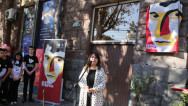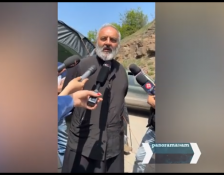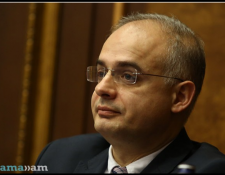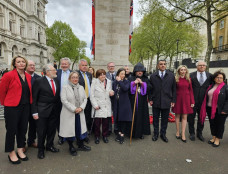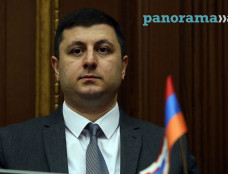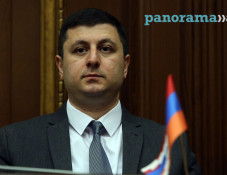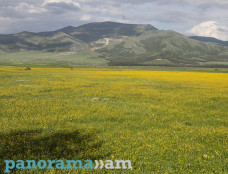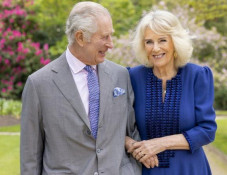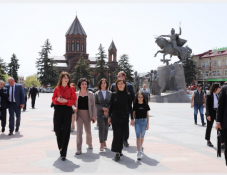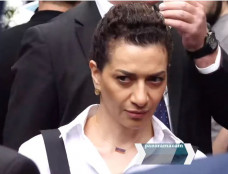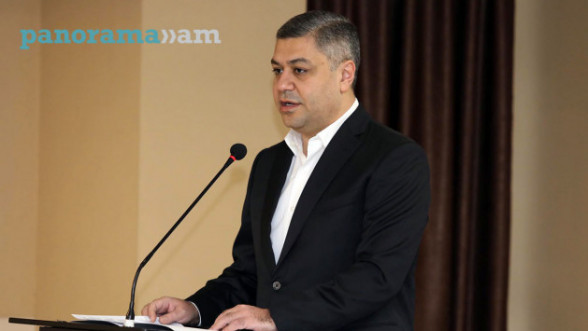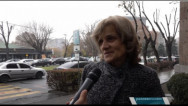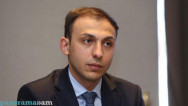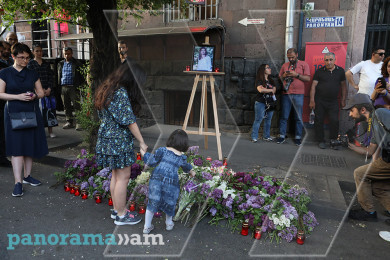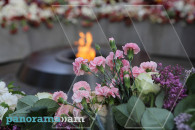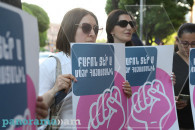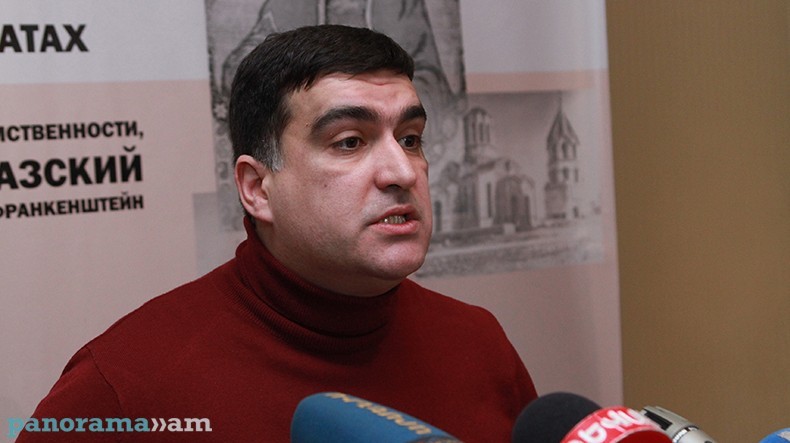
Aris Ghazinyan: Armenian kingdoms appeared and disappeared in Ararat country, but Armenian element always dominated here
Spanish diplomat and traveller Gonzalez de Clavijo, who was the chamberlain of Henry III, the King of Castile and León, and was appointed by him as the ambassador to Timur, left descriptions which vividly illustrate the state of affairs in the Ararat Plain and the demographic situation there after the lame conqueror’s campaigns. Armenian journalist and researcher Aris Ghazinyan writes about it in his book “Yerevan: with a cross or on the cross,” which is an attempt of setting and considering an extremely diverse range of processes directly or indirectly forming the character of the development of the territory in question and predetermining the inevitability of turning Yerevan into the main center of the Eastern Armenia, and later on into the capital of the recovered Armenian state.
“On Saturday, the 13th of May, the road led along the foot of the mountain of the ark of Noah. It was very high, and the summit was covered with snow, and it was without woods <…> great quantities of rye was growing, as if it had been sown by man, but it was useless, and did not come to grain; and there was also plenty of water cresses. At the foot of this mountain they came to ruins of a town long since deserted, which was a league in length; and the people of the country said that it was the first town that was built in the world, after the flood, and that it was founded by Noah and his sons,” Ghazinyan cites the diplomat writing.
In the years of the Kara Koyunlu union’s strengthening, Yerevan was formally still in Tamerlane’s empire. However, as Miran Shah inherited the empire, the rights over Armenia were disputed by Ahmed (“Sultan of Iraq and Armenia”), the chieftain of the Mongol tribe Jalairid, and Qara Yusuf, the dreadful ataman of the “black sheep,” who had joined him.
In 1408, Timurid Miran Shah’s troops suffered a crushing defeat, and he was killed. Two years later, Ahmed Jalairid was killed, too. As a result, the “Armenian Iraqi country” was left to Qara Yusuf. In 1410, the leader of the “black sheep” declared a united state over the inherited ownerless territory and made Tabriz its capital. This was when Yerevan was included in the political Kara Koyunlu. The town found itself in a catastrophic plight in the early 15th century, Ghazinyan writes. Yerevan was subjected to a complete displacement of the Armenian layer and a final devourment by the Turkic one. The town needed a motive for maintaining the traditional life. The motive came in the beginning of the 1400s with the appearance of a person in Yerevan, who still during his lifetime was referred to as “The Ecumenical Bishop,” “The Second Illuminator” and “The Pillar of the Armenian Faith.” This person was the rector of Tatev University, Grigor Tatevatsi.
Tatevatsi’s approach emerged from the fact that Armenian kingdoms appeared and disappeared in the Ararat country in different historical epochs, however, the Armenian element was also dominating here regardless of the political status of the lands. The rector of Tatev University handed a patent for nobility to Yerevan; he found it necessary to grant several of his alumni, including Tovma Metsobetsi, the rank of a teacher at a time in Yerevan. “From that time on, the ancient settlement was to transform into a new image becoming the centre of political, cultural and spiritual life in the territory of the Homeland. Gospels and motets started to be recopied in the town, and Yerevan commenced acquiring features it had not had before,” the author writes.
After Tatevatsi’s death in 1409, it was in Yerevan that Tovma rewrote his teacher’s precepts and started to work on “The Chronicles” and “The History of Tamerlane and His Successors.” Most importantly, Tovma was to turn his teacher’s precept into reality: he brought the residence of the Armenian Pastor back to the Ararat Plain, to Holy Etchmiadzin, Ghazinyan notes.
Kirakos Banaser (“Philologist”) writes the following about it, “May their memory be blessed and Christ the God spare them and all the Christians with prayers! The great Vardapet Grigor Vorotnetsi, who resembled a torch lighted in the world, handed a pastoral staff to Tovma the Monk in the town of Yerevan and honoured him with a vardapet’s degree possessing twelve rights.”
Here, the names of Yerevan-born figures like the scribes Terter Yerevantsi, Nerses Yerevantsi and others start to be frequently mentioned. Jahan Shah’s charter about the liberation of the Church from taxes is especially remarkable. The family burial vault of the Saads, a well-known generation from the “Black Sheep” tribe union, has been preserved in Argavand, a Yerevan suburb.
The residence of the head of the Armenian Apostolic Church officially returned to the Ararat Plain – just 20 km to the west from Yerevan – in 1441 giving the city the motivation it lacked to develop.
Byzantine fell during the 10th year of Catholicos Grigor Makvetsi’s rule. Although the relations between the Armenian and Constantinople clergy were not at their best, the fall of Constantinople in 1453 was a hard blow to the Orthodoxy. Catholicos Simeon Yerevantsi writes the following about it, “Sultan Mehmed seized Constantinople from the Greeks. Since then, the Muslims have conquered all the countries where Greeks, Armenians and Persians lived. The Christian authority ceased.”
The short period of the rule of the political union Kara Koyunlu was also marked with another important event which had a crucial impact on the perspectives of the development of Yerevan. In the first half of the century, it became the centre of a separate governorate (bekdom) and was declared “the capital settlement of the Ararat land.” The establishment of Yerevan Bekdom was a principally new stage of development of the socio-political processes in the Armenian world.
For Yerevan, the 16th century began with the destruction of the Ak Koyunlu union and the declaration of the Safavid Empire by Ismail I. Yerevan became a part of the new empire and the centre of the Safavid governorate (beglerbegdom or beylerbeydom) situated in the Ararat Plain. Ismail was preparing zealously for a war with the Ottoman Empire, which told on Yerevan, as well. “The plight of the city reminded the situation of the late 16th century, when after the Second Division of Armenia, it turned into a border settlement with a significant strategic weight. The players of the great politics changed; the Sunni Ottoman Empire replaced the Orthodox Byzantine Empire, while the Shia power of Turkic Qizilbashes replaced Zoroastrian Iran; only Yerevan was remaining in its historical place,” Ghazinyan writes. According to him, the border and frontline location of the city (as 1000 years ago) pushed Ismail I Safavi to start fortifying the strategically important bastion ahead of the Turkish war.
In the 1500s, Shahanshah Ismail I ordered his vizier Revan Kuli Khan to construct a new fortress in Yerevan, which would be able to ward off the enemy’s assaults, as well as to survive long-lasting sieges. This implied an adjustment of the internal infrastructure and installation of defensive, warehouse and habitable premises, secret entrances and other fortification solutions in the territory of the old fortress. The construction lasted for about seven years, which speaks about the seriousness of Ismail’s intentions to turn Yerevan into a key fortress on the north-western borders on the shahdom, according to Ghazinyan. Besides defensive structures, secular and religious buildings were erected in Yerevan, according to Ghazinyan.
One of the characteristic traits of the time was the formation of Ottoman historiography, which described, presented, argued and explained this or that event and phenomenon in the context of the official policy. As a result, questions over the etymology of the urbonym started to be highlighted, when the medieval Ottoman authors, and today also the Azerbaijani ones often call the city “Revan.”
Back then, Shah Ismail ordered to resettle Bayat tribe into Yerevan. The tribe had appeared in the region during the Chingizids’ invasions, and occupied a prominent place in the resettlement circles during the centuries that followed. The resettlement of the Shia tribes into Yerevan also targeted a strengthening of the Shia element in the strategically important region. Bakikhanov writes the following about it, “Ancient charters show that Shah Ismail resettled the Bayat tribe from Iraq partly to Erivan and partly to Derbend and Sabran to strengthen the local rulers.”
The military campaigns that followed lasted for 222 years in total – from 1513 to 1735. During this period, Yerevan changed its “official registration” for 14 times passing from Persia to Turkey and vice versa every 16 years at average.
In 1554, Sultan Suleyman the Magnificent’s army took up a Yerevan campaign in 1554, “totally destroying and turning into a pile of ashes” both the Shirak region, through which the “troops of Islam” moved, and Yerevan.
Ibrahim Pechevi, a direct participant of the military operations, describes the looting of the Shirak lands by the Ottoman troops: On 19 July, the troops entered Yerevan, where “the wonderful palaces of the Shah, his son, prominent khans and sultans, parks and gardens, and especially the beautiful park Bag-i-Sultaniyye, were burnt and razed to the ground. In the second half of the 16th century, Yerevan was subjected to ravage and ongoing reconstruction, which was conditioned by new wars between the Ottomans and Safavids and the border location of the city. Besides, it was the centre of the beglerbegdom situation in the Ararat plain.
Meanwhile, in the period of Ottoman-Persian campaigns in the middle of the 16th century, certain layers of the Armenian society started to bring forth plans on the recovery of the independent state, presumably with Yerevan as the capital.
In 1547, a secret council was convened in Etchmiadzin with the participation of the highest dignitaries of the church and Ararat meliks (including representatives of hereditary families of Yerevan). The council approved the action program “Incantation of the owners of Armenia” on the establishment of the strategic collaboration with the Catholic Church “for the sake of the salvation and retention of Christianity.” It was decided to delegate an Armenian mission led by Catholicos Stepanos V to the Italian states and to Rome,” Ghazinyan writes. The mission held meetings with the Doge of Venice Francesco Donato, and later presented the “Incantation…” also to Pope Paul III. The delegation remained in the Apennine Peninsula for about a year, and the Pope received the Catholicos Stepanos V several times. Nevertheless, the death of Paul III did not let the parties come to a specific arrangement.
The new pontiff, Julius III, with whom the negotiations continued, set a traditional Catholic condition: to unconditionally recognise the supremacy of Rome, and only then to start the objective dialogue. Stepanos V forcedly read the appeal about the dependent condition of the Armenian Apostolic Church, and completely satisfied the Pope’s vanity. At least, on April 25 1550, Julius III sent letters to German emperor Charles V and Polish king Sigismund II Augustus with an order to receive and hear the Armenian mission.
“Those events could not but be related to Yerevan as the centre of the Eastern Armenia. The assumption that Yerevan was considered as the future capital of the recovered Armenian state in the Etchmiadzin council, is as audacious as grounded,” Ghazinyan writes.
However, the Ottomans and the Safavids learnt about the Armenians’ “Latin contacts”, as a result of which undertook certain steps right after the partition of the Armenian territories in 1555. “In 1557, Shah Tahmasp I granted Ganzak, Barda, Nakhijevan, Lori, Gegharkunik, Kapan, Khoy, Salmast, Zakamsk eparchies to the Etchmiadzin throne in order to suppress the further negotiations between the representatives of the Armenian liberal movement and the western Christian grandees and dignitaries. It is significant that the Ottoman Sultan Suleiman the Magnificent also made a similar concession (simultaneously): he informed (with a special letter) Stepanos V about the personal disposal to hand eparchies already ‘in his part’ of Armenia to the Holy See of Etcmiadzin – Vaspurakan, Baghesh, Amid, Artchesh, Mush and Khlat.
“Therefore, fifteen eparchies were returned to the Etcmiadzin throne during the first two years after another partition of the Armenian lands,” Ghazinyan writes.
With the ascending to the throne of the “licentious and stuffy” son of the Shahanshah Mohammad Khodabanda, the new Ottoman Sultan Murad III spoke against the “coward and careless in wars, weak-sighted and licentious” Shahanshah in 1578. “The twelfth sultan of the Ottoman Empire wanted to finally deal with the Safavids and to simultaneously split the knot of the Armenian contradictions (exposed in the perspective of negotiations with Catholics, projects on the state recovery, and the rise of ‘Yerevan ambitions’),” Ghazinyan writes.
To be continued
Aris Ghazinyan’s “Yerevan: with a cross or on the cross” is a book about the social and political history of Yerevan and Yerevan district (as a habitat) since the declaration of Christianity to the beginning of XIX century. In addition to demonstrating historical facts based on archive documents and sources, the book also considers the fundamental theses of the Azerbaijani historiography and Pan-Turkic ideology aimed at appropriating the historical, cultural, and spiritual heritage of the Armenians and other nations of the region by falsifying their history.
Related news
- Aris Ghazinyan: Timur took thousands of Armenians out of Armenia to develop crafts and trade in his empire
- Aris Ghazinyan: Yerevan became place of pilgrimage for Christians since late 13th century
Newsfeed
Videos




